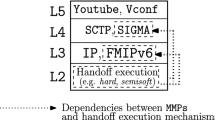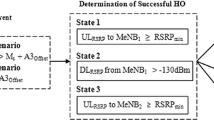Abstract
It is evident that the present and future deployment of multiple radio access technology (RAT), e.g., WLAN, LTE, WiMAX, etc., will advent multi-RAT user equipment (UE). There will be four major challenges due to multi-RATs existence, i.e., fast-reliable signaling, fast-reliable mobility with Quality of Service (QoS), security and reasonable cost. In this paper we deal with performance modeling signaling plane. Most of the reported works present signaling performance between two RATs e.g., EUTRAN to CDMA2000 etc., and vice versa (or single RAT scenarios e.g., UMTS to UMTS). To the best of our knowledge, there has been no analytical modeling approach available for performance analysis of entire control plane operations in a multi-RAT UE, right from cell search to completion of mobility procedures in case of more than two RATs, i.e., a generic model for N-number of RATs. This paper proposes a generic Discrete Time Markov Chain (DTMC) based analytical method for evaluation of control plane operations for multi-RAT mobility procedures. Using the case of UE initiated multi-RAT mobility procedures, for presenting our analytical model we propose an algorithm, integrating and extending some of the known approaches which were mostly limited to single RAT. For this algorithm a generic analytical relationship is derived between time taken by each signaling process in each layer involved in the multi-RAT mobility procedure and the probability of success of the same. Finally, using the above analytical model a case study is presented where the performance of UE initiated mobility procedure for WLAN interworking with LTE supported by Proxy Mobile IP (PMIP) and Media Independent Handover (MIH). With our analytical model, results show that, for a target LTE cell, the increase in probability of successful completion of mobility procedure is 11 % from existing procedures. For target WLAN cell, the same is around 9 %. Notably, the results show how our analytical approach helps in modeling most of the control plane operations in multi-RAT mobility procedures, in a holistic manner.
Similar content being viewed by others
References
Schulzrinne, H., & Wedlund, E. (2001). Application-layer mobility using SIP. Mobile Computing and Communications Review, 1(2).
Schulzrinne, H., & Wedlund, E. (1999). Mobility support using SIP. IEEE/ACM Multimedia conference WOWMOM.
De La Oliva, A., Banchs, A., Soto, I., Mella, T., & Vidal, A. (2008). An overview of IEEE 802.21: Media independent handover services. IEEE Wireless Communications, 15(4).
Moon, C., Yang, S., & Yeom, I. (2007). Performance analysis of decentralized RAN (Radio Access Network) discovery schemes for IEEE 802.21. In IEEE 66th Vehicular Technology Conference, 2007. VTC-2007.
Qureshi, R., Dadej, A., & Fu, Q. (2007). Issues in 802.21 mobile node controlled handovers. In Australasian Telecommunication Networks and Applications Conference, 2007, ATNAC 2007.
3GPP Liaison Package Development Ad hoc Group. Proposed IEEE 802.21 Presentation for 3GPP.
Reinbold, P., & Bonaventure, O. (2003). IP micro-mobility protocols. IEEE Communications Surveys & Tutorials.
Campbell, A. T., Gomez, J., Kim, S., Wan, C.-Y., Turanyi, Z. R., & Valko, A. G. (2002). Comparison of IP micromobility protocols. IEEE Wireless Communications, 9(1).
Ramjee, R., La Porta, T., Thuel, S., Varadhan, K., & Wang, S.Y. (1999). Hawaii: A domain-based approach for supporting in wide-area mobility wireless networks. In Seventh International Conference on Network Protocols.
Valkó, A. G. (1999). Cellular IP: A new approach to internet host mobility. ACM SIGCOMM Computer Communication Review 29(1).
Costa, X. P., Schmitz, R., Hartenstein, H., & Liebsch, M. (2002). A MIPv6, FMIPv6 and HMIPv6 handover latency study: Analytical approach. In IST Mobile and Wireless Telecommunications Summit.
Banerjee, N., Wu, W., & Das, S. K. (2003). Mobility support in wireless internet. IEEE Wireless Communications, 10(5).
IETF RFC 5213, Proxy Mobile IPv6, http://www.ietf.org.
Lei, J., & Fu, X. (2008). Evaluating the benefits of introducing PMIPv6 for localized mobility management. In International wireless communications and mobile computing conference.
Sharma, S., Baek, I., Dodia, Y., & Tzi-cker, C. (2004). OmniCon: A mobile IP-based vertical handoff system for wireless LAN and GPRS links. In International conference on parallel processing workshops.
Kim, D.-H., Kim, W.-T., Lee, H.-G., Kim, S.-J., & Lee, C.-H. (2008). A performance evaluation of vertical hanover architecture with low latency handover. In International conference on convergence and hybrid information technology.
Song, Q., & Jamalipour, A. (2005). Network selection in an integrated wireless lan and umts environment using mathematical modeling and computing techniques. IEEE Wireless Communications, 12(3).
Gelabert, X., Sallent, O., Pérez-Romero, J., & Agustí, R. (2010). Performance evaluation of radio access selection strategies in constrained multi-access/multi-service wireless networks. Elsevier Computer Networks.
Machań, P., Serwin, S., & Woźniak, J. (2008). Performance of mobility support mechanisms in a heterogeneous UMTS and IEEE 802.11 network offered under the IEEE 802.21 standard. In International conference on information technology.
Arjona, A., & Ylä-Jä äski, A. (2007). VoIP call signaling performance and always-on battery consumption in HSDPA, WCDMA and WiFi. In International conference on wireless communications, networking and mobile computing.
Cardenete-Suriol, M., Mangues-Bafalluy, J., Portoles-Comeras, M., Requena-Esteso, M., & Gorricho, M. (2007). VoIP performance in SIP-based vertical handovers between WLAN and GPRS/UMTS networks. In IEEE International Conference on Communications.
Chan-Kyu, H., Hyoung-Kee, C., Woo zBaek, J., & Woo, L. H. (2009). Evaluation of authentication signaling loads in 3GPP LTE/SAE networks. In IEEE 34th Conference on Local Computer Networks.
Tonesi, D.S., Salgarelli, L., Yan, S., & La Porta, T.F. (2008). Evaluation of signaling loads in 3GPP networks. In IEEE Wireless Communications.
Zhang Y., Xiao S., Zhou M., Fujise M. (2006) Authentication traffics modeling and analysis in next generation wireless networks. Wireless Communications and Mobile Computing 5(5): 615–625
Racz, A., Temesvary, A., & Reider, N. (2007). Handover Performance in 3GPP Long Term Evolution (LTE) Systems. In IST Mobile and Wireless Communications Summit.
Aziz, D., & Sigle, R. (2009). Improvement of LTE handover performance through interference coordination. In IEEE Vehicular Technology Conference.
Lunden, P., Aijanen, J., Aho, K., & Ristaniemi, T. (2008) Performance of VoIP over HSDPA in mobility scenarios. In IEEE Vehicular Technology Conference.
Mishra, A. (2003). Performance characterization of signaling traffic in UMTS core networks. In IEEE Global Telecommunications Conference (GLOBECOM).
Halunga, S.V.,& Vizireanu, D. N. (2010). Performance evaluation for conventional andMMSEmultiuser detection algorithms in imperfect reception conditions. Digital Signal Processing, 20(1), 166–178.
Halunga, S. V., Vizireanu, D. N., & Fratu, O. (2010). Imperfect cross-correlation and amplitude balance effects on conventional multiuser decoder with turbo encoding. Digital Signal Processing, 20(1), 191–200.
Dutta, A., et al. (2008). Media-independent pre-authentication supporting secure interdomain handover optimization. IEEE Wireless Communications.
Wang, Y., Ho, P.-H., Shen, S., Li, S., & Naik, S. (2005). Modularized two-step vertical handoff scheme in integrated WWAN and WLAN. In HPSR 2005.
Wu, H., et al. (2007). Proactive scan: Fast handoff with smart triggers for 802.11 Wireless LAN. In INFOCOM 2007.
Chen, Y.-S., Chen, C.-K., & Chuang, M.-C. (2006). DeuceScan: Deuce-based fast handoff scheme in IEEE 802.11 Wireless Networks. In VTC 2006.
AROMA White paper, Radio access technology selection in heterogeneous networks: aroma’s view. http://www.aroma-ist.upc.edu/publicdocuments/whitepapers/WP_CRRM_final.pdf.
Grinstead, C. M., & Snell, J. L. Introduction to probability. http://www.dartmouth.edu/~chance/teaching_aids/books_articles/probability_book/book.html.
3GPP TS 25.331 V6.17.0. Radio resource control (RRC). http://www.3gpp.org/.
3GPP TS 44.018 V6.23.0 (GSM/EDGE). Radio resource control (RRC). http://www.3gpp.org/.
3GPP TS 24.234 V8.3.0. WLAN user equipment (WLAN UE) to network protocols. http://www.3gpp.org/.
3GPP TS 36.211 V8.5.0. Physical channels and modulation. http://www.3gpp.org/.
3GPP TS 36.321 V8.7.0. Medium access control (MAC) protocol specification. http://www.3gpp.org/.
3GPP TS 36.322 V8.7.0. Radio link control (RLC) protocol specification. http://www.3gpp.org/.
3GPP TS 36.323 V8.6.0. Packet dataconvergence protocol (PDCP)specification. http://www.3gpp.org/.
3GPP TS 36.331 V8.7.0. Radio resource control (RRC). http://www.3gpp.org/.
3GPP TS 36.133 V9.0.0. Requirements for support of radio resource management. http://www.3gpp.org/.
3GPP TS 36.213 V8.5.0. Physical layer procedures. http://www.3gpp.org/.
3GPP TS 36.304 V8.7.0. User equipment (UE) procedures in idle mode. http://www.3gpp.org/.
3GPP TS 23.402 V8.7.0. Architecture enhancements for non-3GPP accesses. http://www.3gpp.org/.
3GPP TS 23.234 V8.0.0. 3GPP system to wireless local area network (WLAN) interworking; System description. http://www.3gpp.org/.
3GPP TS 36.300 V8.10.0. E-UTRAN - Overall description. http://www.3gpp.org/.
IETF RFC 4187. Extensible authentication protocol method for 3rd generation authentication and key agreement (EAP-AKA). http://www.ietf.org.
IEEE 802.11 specification. Wireless LAN medium access control (MAC) and physical layer (PHY) specifications. http://www.ieee.org.
Bumiler, G. IEEE 802.11u and Cellular System Interworking. https://mentor.ieee.org/802.11/dcn/09/11-09-0730-00-000u-ieee-802-11u-and-cellular-system-interworking.ppt.
Gast, M. 802.11u Bootstrap Procedure with 802.21. https://mentor.ieee.org/802.11/public/07/11-07-0267-00-000u-802-11u-bootstrap-with-802-21.ppt.
Author information
Authors and Affiliations
Corresponding author
Rights and permissions
About this article
Cite this article
Das, D., Das, D. An Analytical Evaluation Approach for Control Plane Operations of a Multi-RAT Mobility Procedures in a User Equipment. Wireless Pers Commun 69, 1309–1332 (2013). https://doi.org/10.1007/s11277-012-0635-1
Published:
Issue Date:
DOI: https://doi.org/10.1007/s11277-012-0635-1




